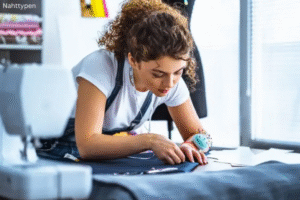Nahttypen: The Ultimate Guide to Different Seam Types in Sewing and Textiles

Sewing is an art that combines creativity, craftsmanship, and technical knowledge. One of the most important aspects of sewing is understanding Nahttypen—the various seam types used to join fabrics together. Whether you are a fashion designer, hobbyist, or industrial professional, knowing the right Nahttypen can make a huge difference in the durability, appearance, and functionality of your projects.
In this comprehensive guide, we will explore everything about Nahttypen, including the latest trends, practical tips, and how to choose the best seam type for different fabrics and purposes. We will also answer common questions to help you become a seam expert.
What Are Nahttypen? (Seam Types)
Nahttypen is the German term for “seam types,” referring to the different ways fabrics are sewn together. Each Nahttyp has its unique features, strengths, and suitable applications. Choosing the right Nahttyp ensures your projects look professional, last longer, and meet specific needs like stretchability or aesthetics.
Seams are the backbone of any sewn product. They hold fabrics together securely, prevent fraying, and contribute to the overall look. With the rise of sustainable fashion, technical textiles, and smart fabrics, understanding Nahttypen has become more important than ever.
Why Are Nahttypen Important?
Knowing about Nahttypen is crucial for several reasons:
- Durability: Different seam types offer varying levels of strength, which is vital for items that undergo stress or frequent washing.
- Appearance: Some seams provide a clean, minimal look, while others are decorative.
- Functionality: Certain seams allow for stretch, flexibility, or waterproofing—essential for activewear, outdoor gear, or technical textiles.
- Fabric Preservation: Choosing the right Nahttyp helps prevent fraying, tearing, or fabric damage.
- Professional Finish: Proper seam types elevate the quality of your sewing projects, making them look polished and well-made.
Popular Nahttypen in Garment Construction
Let’s explore the most widely used Nahttypen, their features, advantages, and ideal applications.
1. Plain Seam (Geradstichnaht)
Description:
The most basic and common seam, created by sewing two fabric pieces with right sides facing each other. The raw edges are pressed open, creating a flat, clean seam.
Best for:
- Shirts
- Light dresses
- Casual wear
- Lightweight fabrics
Advantages:
- Easy to sew with a standard sewing machine
- Quick and simple to construct
- Creates a neat, minimal appearance
Tips:
Ensure your seam allowance is consistent for a smooth finish. Press the seam open for a flatter look.
2. French Seam (Französische Naht)
Description:
A refined seam where raw edges are fully enclosed within the seam, giving a clean finish on both sides.
Best for:
- Lingerie
- Blouses
- Silk, chiffon, and delicate fabrics
Advantages:
- No raw edges visible
- Prevents fraying effectively
- Looks elegant and professional
Tips:
Ideal for delicate fabrics; requires precise sewing.
3. Flat-Felled Seam (Kappnaht)
Description:
A highly durable seam where raw edges are folded inside and stitched down, often double-stitched for strength.
Best for:
- Jeans
- Workwear
- Heavy-duty outdoor clothing
Advantages:
- Very strong and long-lasting
- No visible raw edges
- Great for high-stress areas
Tips:
Requires more sewing steps but pays off in durability.
4. Overlock Seam (Overlocknaht)
Description:
Created using an overlock or serger machine. It trims, sews, and finishes edges in one step, providing a clean, stretchy seam.
Best for:
- T-shirts
- Stretch fabrics
- Undergarments
Advantages:
- Fast and efficient
- Flexible, allowing stretch
- Prevents fraying
Tips:
Ideal for knitwear and stretchy fabrics.
5. Zigzag Seam (Zickzacknaht)
Description:
A zigzag stitch used mainly for finishing raw edges or sewing stretchy fabrics. It can also be decorative.
Best for:
- Elastic fabrics
- Temporary seams
- Decorative stitching
Advantages:
- Allows for stretch
- Easy to apply on a standard sewing machine
Tips:
Use a zigzag stitch for finishing edges that need flexibility.
6. Lapped Seam (Überlappungsnaht)
Description:
Two fabric pieces are overlapped and stitched through both layers. Often used in leatherwork or heavy fabrics.
Best for:
- Leather products
- Upholstery
- Heavy textiles
Advantages:
- Strong and supportive
- Minimal bulk
- Decorative options with topstitching
Tips:
Provides a sturdy join, especially in industrial applications.
How to Choose the Right Nahttyp
Selecting the appropriate Nahttyp depends on several factors:
1. Fabric Type
- Delicate fabrics like silk or chiffon benefit from French seams or narrow finishes to prevent fraying.
- Heavy fabrics like denim or leather require flat-felled or lapped seams for strength.
- Stretch fabrics need seams that allow flexibility, such as overlock or zigzag seams.
2. Garment’s Function
- Will the item undergo frequent washing or stress? Use strong seams like flat-felled or reinforced lapped seams.
- Does the seam need to be invisible? French seams or bound seams are better.
- Is stretch necessary? Overlock or zigzag seams are suitable.
3. Sewing Machine Capabilities
- Basic sewing machines can handle plain seams, zigzag stitches, and some decorative stitches.
- Overlock or serger machines are necessary for overlock seams.
- Industrial machines can produce specialized seams like flat-felled or lapped seams.
Trends in Nahttypen and Sewing
In recent years, Nahttypen have evolved with technology and fashion trends:
- Seam tape technology: Used to waterproof or reinforce seams, especially in outdoor gear.
- Ultrasonic welding: Used in technical textiles for seamless, waterproof joins without stitches.
- Decorative seams: Topstitching and contrasting seams are popular in streetwear and high fashion.
- Eco-friendly seams: Reduced seam allowances and minimal stitching help cut waste and promote sustainability.
Nahttypen in Industrial and Technical Sewing
Beyond clothing, Nahttypen are vital in industries like:
- Medical textiles: Seams that are antibacterial, sealed, or waterproof.
- Automotive industry: Durable flat seams and decorative stitching in car interiors.
- Outdoor gear: Waterproof seams achieved through taping or ultrasonic welding.
- Aerospace: High-strength seams in technical fabrics used in space suits or aircraft.
Maintenance and Durability of Nahttypen
Proper care extends the lifespan of sewn products:
- Plain seams may unravel if not finished properly; serging or binding edges helps.
- Overlock seams retain flexibility but can stretch out if poorly sewn.
- Flat-felled seams are extremely durable, suitable for repeated washing and heavy use.
- French seams require gentle handling to preserve their neat finish.
Always follow manufacturer instructions for washing and handling to keep your Nahttypen in top condition.
FAQs About Nahttypen
Q1: What is the best seam type for beginner sewing?
A: The plain seam is the easiest and most versatile for beginners. It’s simple to sew and serves as the foundation for many projects.
Q2: Can I use a zigzag stitch instead of an overlock seam?
A: Yes, zigzag stitches can finish raw edges similarly but may not be as durable or neat as an overlock seam. For professional results, a serger is preferred.
Q3: How do I choose the right seam for stretch fabrics?
A: Use seams that allow flexibility, such as overlock or zigzag seams, to prevent the fabric from breaking or puckering.
Q4: Are French seams suitable for all fabrics?
A: French seams work best with lightweight, delicate fabrics. They may add bulk in heavy fabrics, so choose accordingly.
Q5: How can I make my seams more durable?
A: Reinforce stress points, choose the correct Nahttyp for your fabric, and finish seams properly with serging or binding.
Final Thoughts: Mastering Nahttypen for Better Sewing Projects
Understanding Nahttypen is essential for anyone serious about sewing. The right seam not only enhances the look but also ensures your project’s longevity and functionality. Whether you want neat, professional finishes or strong, industrial-strength seams, knowing the various Nahttypen empowers you to make better choices.
As sewing technology advances, new Nahttypen and seam innovations continue to emerge, offering even more possibilities. Stay updated with the latest trends and always consider your fabric, purpose, and tools when selecting the perfect seam.
Remember: Mastering Nahttypen takes practice, but it’s a skill that transforms your sewing projects from amateur to professional quality. Happy sewing!




